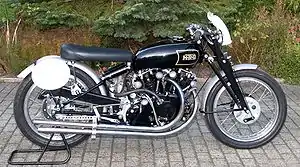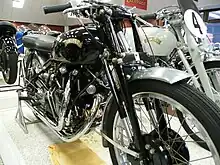Vincent Black Lightning
The Vincent Black Lightning was a Vincent-HRD motorcycle first built in September 1948 at the Vincent works in Great North Road, Stevenage, Hertfordshire, UK, and produced from 1948 to 1952. The bike was a purpose-built factory modified Black Shadow that was then named and produced as the Black Lightning. At the time the Black Lightning was the fastest production motorcycle in the world.[1]
 | |
| Manufacturer | Vincent HRD |
|---|---|
| Production | 1948–1952 |
| Engine | 998 cc (60.9 cu in) V-twin, pushrod OHV, air-cooled |
| Compression ratio | 6.8:1 to 12.5:1 |
| Power | 70 bhp (52 kW)[1] |
| Wheelbase | 55.5 in (1,410 mm) |
| Fuel capacity | 3.75 imperial gallons (17.0 L) |
| Related | Vincent Black Shadow |
Development

Vincent-HRD began motorcycle production in 1928 and were well established after World War II when they launched the 1,000 cc (61 cu in) Black Lightning. This was a production version of the Black Lightning which held the motorcycle land-speed record, with a similar engine specification.[2]
Available to order, a standard Black Lightning was supplied in racing trim with magnesium alloy components, special racing tyres on alloy rims, rear-set foot controls, a solo seat and aluminium mudguards. This reduced the Lightning's weight to 380 lb (170 kg).[1][3] The 998 cc (60.9 cu in) air-cooled OHV pushrod V-twin specifications were always based on standard parts but upgraded with higher-performance racing equipment. The Black Lightning had higher-strength connecting rods, larger inlet ports, polished rocker gear, steel idler gears, racing carburettors, and a manual-advance magneto, and was available with compression ratios between 6.8:1 and 12.5:1.[4] This resulted in 70 bhp (52 kW) and a top speed of 150 mph (240 km/h). Only 31 Black Lightnings were ever built before production ended in 1952 because of Vincent's financial problems.[1]
US record and picture


On 13 September 1948, Rollie Free achieved the US national motorcycle speed record at Bonneville Salt Flats in Utah riding the first Vincent Black Lightning. During test runs Free reached average speeds of 148.6 mph (239.1 km/h). To reduce drag, Free stripped to his swimming shorts for the final run, which he made lying flat with his legs stretched out and his head low, guiding the Vincent by following a black stripe painted on the salt bed. The stunt worked as Free covered the mile in 23.9 seconds, passing the 150 mph (240 km/h) barrier and on the return run he reached a record average speed of 150.313 mph (241.905 km/h).[5][6][7][3][8] This led to one of the most famous photographs in motorcycle history, known as the "bathing suit bike". The American Motorcyclist Association certified Free's record. Innovative features of the bike included the first-ever Vincent rear shock absorber, the first Mk II racing cams and horizontally mounted racing carburettors.[8][1] In 1950, Rollie Free returned to the Bonneville Salt Flats and broke his own record, averaging speeds of 156.58 mph (251.99 km/h) on the Vincent despite a high-speed crash during those speed trials.[5]
Auction record
In February 2018, during an auction held by Bonhams at Las Vegas, a Black Lightning, stated to be one of only 19 surviving, set a world record for the highest-price paid at auction for a motorcycle of $US929,000 ($1.16 million Australian). The machine was used to set a national speed record in Australia during 1953, and was purchased by an undisclosed Australian.[9]
Richard Thompson song
Richard Thompson wrote the song "1952 Vincent Black Lightning" and recorded it for his 1991 album Rumor and Sigh.[10] Thompson later said, "When I was a kid, that was always the exotic bike ... the one that made you go 'ooh, wow'".[11] The song's outlaw hero James, who has "robbed many a man to get my Vincent machine," comments on the bike's mystique in his dying speech:
Says James: "In my opinion,
there's nothing in this world,
beats a '52 Vincent,
and a red-headed girl.
Now Nortons, and Indians, and Greeveses won't do;
they don't have a soul
like a Vincent '52."[12]
See also
Notes
- "The Fastest Production Bike In The World!". Archived from the original on 6 February 2009. Retrieved 7 February 2009.
- "The Dearden Supercharged Vincent Black Lightning". Retrieved 7 February 2009.
- Wapling, Greg. "Burns & Wright Vincent Black Lightning". Hot Rods Down Under. Retrieved 31 December 2017.
- "Vincent Motorcycles". Retrieved 7 February 2009.
- "Rollie Free". Retrieved 24 February 2012.
- Tooth, Phillip. "Rollie Free and the Bathing Suit Bike". Motorcycle Classics, November/December 2010. Accessed: 19 May 2013.
- Ensanian, Greg (22 November 2016). Discovering the Motorcycle: The History. The Culture. The Machines. Equus Potentia Publishing. p. 414. ISBN 978-0996391900. Retrieved 31 December 2017.
- Wasef, Basem; Leno, Jay (15 October 2007), Legendary Motorcycles, Motorbooks International, pp. 33–39, ISBN 978-0-7603-3070-8, retrieved 31 December 2017
- Land speed record-breaking motorcycle to return to Australia after setting top auction price ABC Radio Sydney 2 February 2018. Retrieved 28 July 2018
- Gross, Ken (15 September 2009). "Leno's Black Shadow". In Tom Cotter (ed.). The Vincent in the Barn: Great Stories of Motorcycle Archaeology. MotorBooks International. p. 253. ISBN 9781616730277. Retrieved 28 March 2014.
- "Richard Thompson: Solitary Life – BBC Four". bbc.co.uk. Retrieved 7 December 2016.
- ""1952 Vincent Black Lightning," By Richard Thompson " American Songwriter". americansongwriter.com. 12 August 2012. Archived from the original on 14 August 2012. Retrieved 7 December 2016.